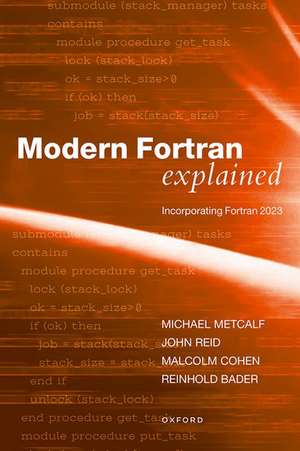Modern Fortran Explained: Incorporating Fortran 2023
Autor Michael Metcalf, John Reid, Malcolm Cohen, Reinhold Baderen Limba Engleză Paperback – 7 dec 2023
| Toate formatele și edițiile | Preț | Express |
|---|---|---|
| Paperback (1) | 330.90 lei 10-16 zile | +65.05 lei 10-14 zile |
| OUP OXFORD – 7 dec 2023 | 330.90 lei 10-16 zile | +65.05 lei 10-14 zile |
| Hardback (1) | 876.09 lei 3-5 săpt. | |
| OUP OXFORD – 7 dec 2023 | 876.09 lei 3-5 săpt. |
Preț: 330.90 lei
Preț vechi: 354.35 lei
-7% Nou
Puncte Express: 496
Preț estimativ în valută:
63.32€ • 66.29$ • 52.39£
63.32€ • 66.29$ • 52.39£
Carte disponibilă
Livrare economică 04-10 martie
Livrare express 04-08 martie pentru 75.04 lei
Preluare comenzi: 021 569.72.76
Specificații
ISBN-13: 9780198876588
ISBN-10: 0198876580
Pagini: 576
Dimensiuni: 157 x 235 x 28 mm
Greutate: 0.95 kg
Ediția:6
Editura: OUP OXFORD
Colecția OUP Oxford
Locul publicării:Oxford, United Kingdom
ISBN-10: 0198876580
Pagini: 576
Dimensiuni: 157 x 235 x 28 mm
Greutate: 0.95 kg
Ediția:6
Editura: OUP OXFORD
Colecția OUP Oxford
Locul publicării:Oxford, United Kingdom
Recenzii
Modern Fortran Explained does an admirable job of detailing the cutting edge developments surrounding this legendary program language, over the last 20 years. An appreciated feature of the text is the beautifully woven narrative which presents Fortran from its foundations to its most complex structures.
Notă biografică
After studying physics at University College London and a short spell at ICT, Michael Metcalf spent 32 years working on evaluation of data from large high-energy physics experiments at CERN, Geneva. He became a group leader and senior scientist. During this time, he became involved in Fortran standardization and was a member of the relevant committees for seven years. He wrote a number of books on the topic and lectured extensively. Now he is retired and resides in Berlin.After reading mathematics at Oxford University, John Reid lectured at Sussex University for five years and joined the numerical analysis group at Harwell, which moved to the Rutherford Appleton Laboratory in 1990. He wrote many Fortran programs for the group which appeared in the HSL Library. His research has mainly been on direct methods for sparse matrices. He has participated in Fortran standardization since 1983 and was convener of the ISO committee from 2000 to 2017. Now he is an Honorary Scientist at the Rutherford Appleton Laboratory and he continues to participate in Fortran standardization.After studying Computer Science and Mathematics at the Australian National University, Malcolm Cohen worked as a programmer in the public sector for three years. He joined the Numerical Algorithms Group in 1984 to work on Fortran Software Tools. Later, he took a year off in Iceland in 1987 to learn Icelandic, C, and graphics programming, and rejoined the NAG in 1988. He has been a member of the ISO/IEC Working Group on Fortran since 1988 and wrote the world's first Fortran 90 compiler, which released in September 1991. He has been the Editor of the ISO/IEC Fortran standard since 2005, responsible for Fortran 2008, Fortran 2018, and Fortran 2023. He was seconded to NAG's Tokyo office in 2006, and currently resides in Japan.After studying physics at Ludwig-Maximilians University in Munich, Reinhold Bader completed a PhD in solid state physics in 1998. He became a scientific staff member at LRZ in 1999 and group leader of the HPC systems and services in 2012. He developed basic and advanced course material for Fortran and other HPC topics since 2000 and has been involved with Fortran standardization in the context of WG5 since 2008. He is now officially a DIN representative (through LRZ) since 2013.
